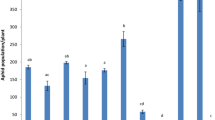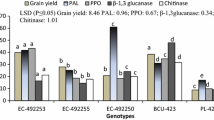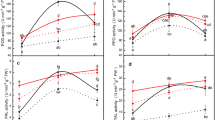Abstract
Suitable winter wheat cultivars of different degree of resistance to cereal aphids, Sitobion avenae F. and Rhopalosiphum pali L. have been studied in the field conditions. The differences in the chemical composition of possible attractants and repellants have been analysed. The results confirm the interpendence between contents of yellow and orange plant pigments in the leaves of the studied varieties and their preference by the aphids. The leaves of the susceptible cultivars also had the highest level of sucrose. The number of the aphids was directly proportional to the total free amino acids content. The higher degree of resistance of the cultivars was related to the contents free phenols in their tissues and was also associated with a high value of ‘toxicity index’, which is the ratio of free phenols content to free amino acids content. Also the contents of structural polysaccharides (cellulose, hemicelluloses and pectins) of the investigated cultivars were inversely proportional to the degree of their infestation.
Résumé
Des cultivars de blé d’hiver appropriés ayant differents degrés de résistance aux aphidés Sitobion avenae F. et Rhopalosiphum padi L. ont été étudiés dans des conditions expérimentales. La différence quant à la composition chimique des differents attractifs et répulsifs a été analysée. Les résultats ont confirmé [’sinterdependence entre la quantité des pigments jaunes et oranges dans les feuilles des variétés étudiés et leur préférence par les aphidés. Un haut niveau de sucrose a été aussi observé dans les feuilles des cultivars susceptibles. Les effectifs des aphidés étaient directement proportionnnels à la quantité des acides aminés libres. Il y avait un rapport entre le haut degré de résistance des cultivars et la quantité de phénols libres dans leurs tissus et le haut niveau de l’indice de toxicité qui est le rapport des phénols libres aux acides aminés libres. En outre, la quantité de polysacharides structuraux, de cellulose, hémicelluloses et pectines des cultivars analysés étaient inversement proportionnelle au degré de leur infestation.
Similar content being viewed by others
References
AOAC (1975) Official Methods of Analysis, 12th edn. Association of Official Analytical Chemists, Washington, D.C.
Arnon D. I. (1949) Copper enzymes in isolated chloroplasts. Polyphenoloxidase in Beta vulgaris. PI. Physiol. 24, 1–15.
Beck S. D. (1965) Resistance of plant to insects. A. Rev. Ent. 10, 207–231.
Bernays E. A. and Chapman R. F. (1977) Deterrent chemicals as a basis of oligophagy in Locusta migratoria. Ecol. Ent. 2, 1–18.
Birch N. and Wratten S. D. (1984) Patterns of aphid resistance in the genus Vicia. Ann. appl. Biol. 104, 327–338.
Blaim K. and Przeszlakowska M. (1968) Wyodrębnianie i oznaczanie substancji pektynowych w materiale roslinnym. Annls Univ. Mariae Curie-Sklodowska. 23, 257–263.
Brown H. D. (1972) The suitability of some crops to infestation by the wheat aphid, Schizaphis graminum (Homoptera: Aphididae). Entomologia exp. appl. 15, 128–138.
Cartier J. J. (1966) Aphid responses to colors in artificial rearings. Bull. ent. Soc. Am. 12, 378–380.
Coon B. F., Miller R. C. and Aurand L. W. (1948) Correlation between the carotene content of corn and infestation by the corn leaf aphid. Penn. Agric. Expt Sta. Dept Zool. Ent. Multilith Report.
Dabrowski Z. T. (1978) Właściwości roślin żywicielskich a zwalczanie szkodników. In Biologiczne Metody Walki ze Szkodnikami Roślin (Edited by Boczek J. and Lipa J. J.), pp. 509–529. PWN, Warszawa.
Dewar A. M. (1977) Assessment of methods for testing varietal resistance to aphids in cereal. Ann. appl. Biol. 87, 183–190.
Dreyer D. L. and Jones K. C. (1981) Feeding deterrency of flavonoids and related phenolics towards Schizaphis graminum and Myzus persicae: aphid feeding deterrents in wheat. Phytochemistry 20, 2489–2493.
Dreyer D. L. and Campbell B. C. (1983) Degree of intercellular pectins associated with plant resistance to aphids and with induction of aphids biotypes. Experientia 6, 1–11.
Dreyer D. L., Reese J. C. and Jones K. C. (1981) Aphid feeding deterrents in sorghum. Bioassay, isolation and characterization. J. chem. Ecol. 7, 273–284.
Erlich P. R. and Raven P. H. (1967) Butterflies and plants. Scient. Am. 216, 104–113.
Ezueh M. I. (1981) The biological basis of resistance in cowpea to the cowpea moth (Cydia ptychora). Ann. appl. Biol. 99, 313–321.
Georghiou G. P. and Taylor C. E. (1977) Pest resistance as an evolutionary phenomenon. Proceedings XVth International Congress on Entomology, Washington, D.C., pp. 759–785.
Guenzi W. D. and McCalla T. M. (1966) Phenolic acids in oats, wheat, sorghum and corn residues and their phytotoxicity. Agron. J. 58, 303–304.
Heyland K. V. (1959) Der Verlaf der Eingangerung con Gordsubstanzen und anderes Kohlenhydraten in den Spross von Weizen und Roggen zwischen Ahrenschieben und todriefe. Z. Acker.-u. Pfl Bau 108, 477–479.
House H. L. (1972) Insect nutrition. In Biology of Nutrition (Edited by Fiewnes R. N.), Vol. 18, pp. 513–537. Pergamon Press, New York.
House H. L. (1974) Nutrition. In The Physiology oflnsecta, Vol. V, pp. 1–62. Academic Press, New York.
Kennedy J. S. (1976) Host-plant finding by flying aphids. Symp. Biol. Hung. 16, 121–123.
Kennedy J. S. and Stroyan H. L. G. (1959) Biology of aphids. A. Rev. Ent. 4, 139–150.
Kieckhefer R. W., Dickmann D. A. and Miller E. L. (1976) Color responses of cereal aphids. Ann. ent. Soc. Am. 69, 721–724.
Lasheen A. M., Chaplin C. E. V. and Harmon R. N. (1970) Biochemical comparison of fruit buds in five peach cultivars of varying degrees of cold hardiness. J. Am. Soc. hort. Sci. 95, 177–181.
Leszczyński B., Warchoł J. and Niraz S. (1985) The influence of the phenolic compounds on the preference of winter wheat cultivars by cereal aphids. Insect Sci. Applic. 6, 157–158.
Lowry O. H., Rosebrough N. J., Farr A. L. and Randall R. J. (1951) Protein measurement with the Folin phenol reagent. J. biol. Chem. 193, 256–275.
Macfoy C. C. A. and Dabrowski Z. T. (1984) Preliminary studies on cowpea resistance to Aphis craccivora Koch (Hom., Aphididae). Z. angew. Ent. 97, 202–209.
McKey D. (1974) Adaptive patterns in alkaloid physiology. Am. Nat. 108, 305–320.
McNeill S. and Southwood T. R. E. (1978) The role of nitrogen in the development of insect/plant relationships. In Biochemical Aspects of Plant and Animal Coevolution (Edited by Harborne J. B.). Academic Press, New York.
Morris D. L. (1948) Quantitative determination of carbohydrates with Dreywood’s anthrone reagent. Science 107, 254–255.
Nelson N. (1944) A photometric adaptation of the Somogyi method for the determination of glucose. J. biol. Chem. 153, 375–380.
Niraz S. and Andruszewska A. (1967) Analiza wolnych aminokwasów i cukrów w technicznie dojrzalych lisciach Machorki Pomorskiej i tytoniu Mocnego Skroniowskiego. Biul. C.L.P.T. 34, 85–95.
Norris D. M. and Kogan M. (1980) Biochemical and morphological bases of resistance. In Breeding Plants Resistant to Insects (Edited by Maxwell F. G. and Jennings P. R.), pp. 19–62. Wiley, New York.
Rautapää J. (1980) Light reactions of cereal aphids (Homoptera, Aphididae). Ann. Ent. Fenn. 46, 1–12.
Schoonhoven L. M. (1974) Comparative aspects of taste receptor specificity. In Transduction Mechanisms in Chemoreception (Edited by Poynder T. N.), pp. 189–201. Information Retrieval Ltd, London.
Singh M., Singh S. S. and Sanwall G. G. (1978) A new colorimetric method for determination of phenolics. Ind. J. exp. Biol. 16, 712–714.
Southwood T. R. E. (1973) The insect plant relationships — an evolutionary perspective. In Insect Plant Relationships (Edited by Emden M. F. van), pp. 3–30. Blackwell Scientific, Oxford.
Strzelecka H., Kamińska J. and Walewska E. (1982) Oznaczanie zawartości flawonoidów metoda Christa-Müllera. In Chemiczne Melody Badan Roślinnych Surowców Leczniczych, pp. 57–58. PZWL, Warsaw.
Todd G. W., Getahun A. and Cress D. D. (1971) Resistance in barley to the greenbug Schizaphis gramium. 1. Toxicity of phenolic and flavonoid compounds and related substances. Ann. ent. Soc. Am. 64, 718–722.
Tottman D. R. and Makepeace R. J. (1979) An explanation of the decimal code for the growth stages of cereals, with illustrations. Ann. appl. Biol. 93, 221–234.
Van Emden H. F., Eastop V. F., Hughes R. D. and Way M. J. (1969) The ecology of Myzus persicae. A. Rev. Ent. 14, 197–270.
Vickerman G. P. and Wratten S. D. (1979) The biology and pests status of cereal aphids (Hemiptera: Aphidadae) in Europe: a review. Bull. ent. Res. 69, 1–32.
Wilde J. de, Brader L. and Ticheler J. (1964) Factors affecting host plant acceptance in some Coleoptera. Proceedings XIIth International Congress on Entomology, pp. 550–552.
Woodhead S., Padgham D. E. and Bernays E. A. (1980) Insect feeding on different sorghum cultivars in relation to cyanide and phenolic acid content. Ann. appl. Biol. 95, 151–157.
Wratten S. D., Lee G. and Stevens D. J. (1979) Proceedings 1979 British Crop Protection Conference, Pests and Diseases, Vol. 1, pp. 1–8.
Author information
Authors and Affiliations
Rights and permissions
About this article
Cite this article
Niraz, S., Leszczyński, B., Ciepiela, A. et al. Biochemical Aspects of Winter Wheat Resistance to Aphids. Int J Trop Insect Sci 6, 253–257 (1985). https://doi.org/10.1017/S1742758400004513
Received:
Revised:
Published:
Issue Date:
DOI: https://doi.org/10.1017/S1742758400004513
Key Words
- Cereal aphids
- winter wheat resistance
- antibiosis
- non-preference
- amino acids
- cellulose
- hemicelluloses
- pectins
- plant phenols
- plant pigments
- proteins
- sucrose




